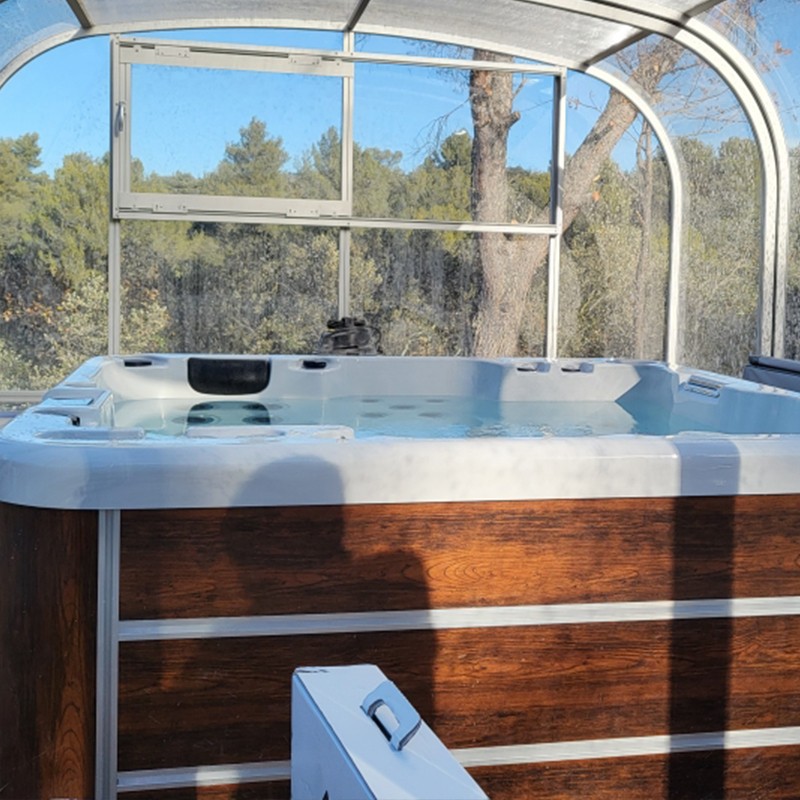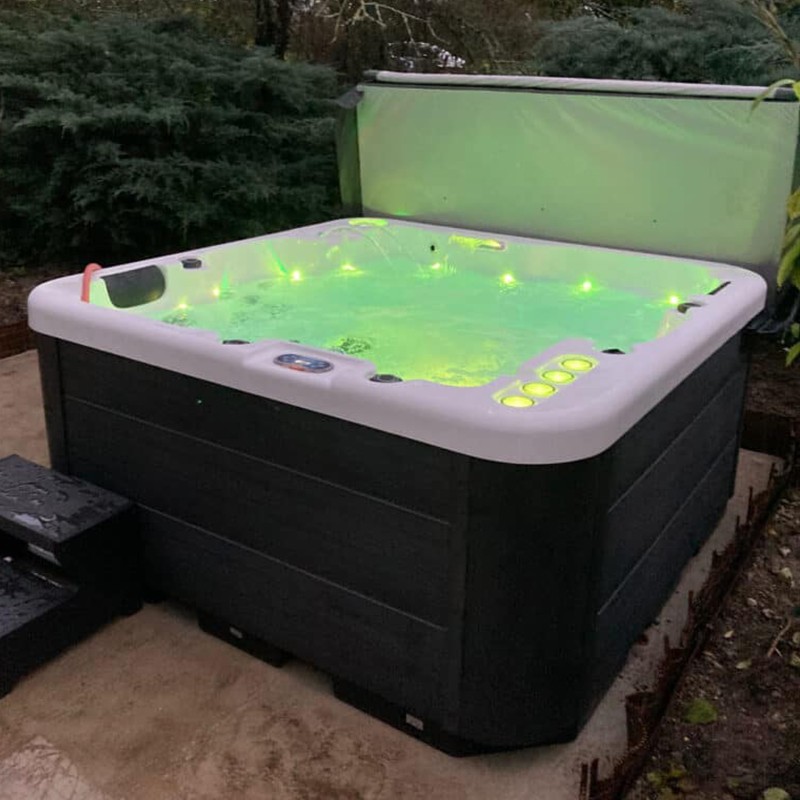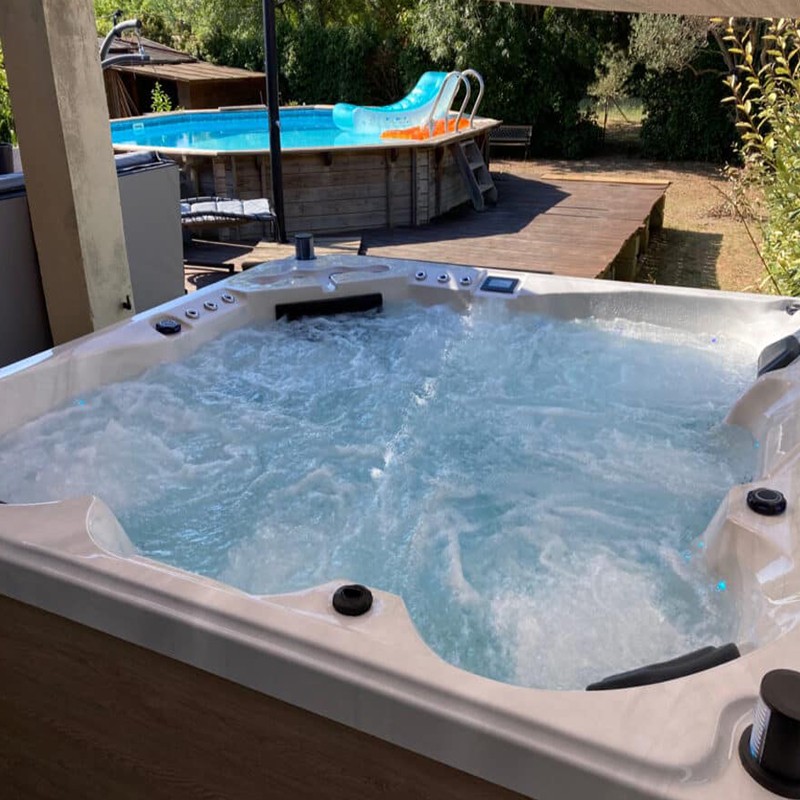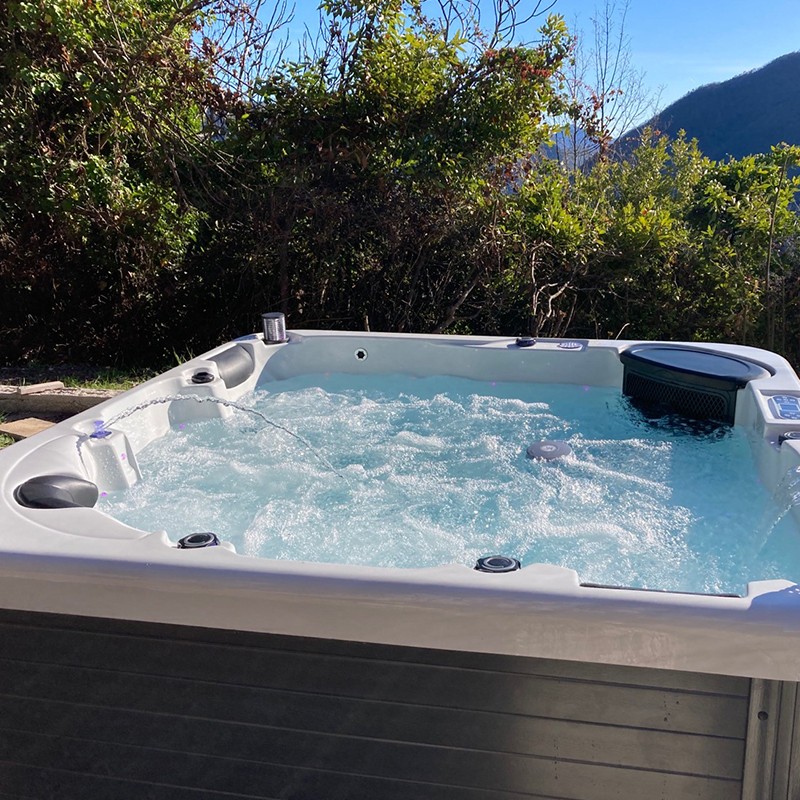
Do hot tubs equipped with ozone generators need to add chemicals?
2024-12-03 15:30Ozone generators are a common hot bathtub accessory. Their main function is to keep the water clean by releasing ozone gas to kill bacteria and microorganisms in the water. This makes many people mistakenly believe that hot tubs equipped with ozone generators no longer need to add additional chemicals. However, this is not the case. This article will explore this issue in depth to help users better understand the role of ozone generators and their relationship with chemicals.

How does an ozone generator work? Can it really replace chemicals?
How does an ozone generator work?
Ozone generators ionize oxygen (O2) in the air to produce ozone (O3) with strong oxidizing power. Ozone can quickly destroy bacteria, viruses and other organic matter in the water, oxidizing them into harmless byproducts. Due to its strong bactericidal function, ozone generators are often used as auxiliary purification tools in hot tubs. The main advantage of ozone generators is that they can reduce the need for traditional chemical disinfectants such as chlorine or bromine, reduce chemical residues and irritating odors, and keep the water clear. However, ozone has a very short lifespan, usually only lasting 10 to 20 minutes in water. Therefore, it cannot provide a continuous disinfection effect and still needs to rely on other chemicals to maintain the stability of water quality.
The specific working process is as follows:
1. Oxygen conversion: The ozone generator uses corona discharge or ultraviolet irradiation to decompose and recombine oxygen in the air to form ozone molecules.
2. Injection into water: Ozone enters the hot bathtub water through an injection device and reacts with pollutants in the water, thereby destroying their molecular structure and achieving the effect of sterilization and disinfection.
Can ozone completely replace chemicals?
Although ozone has strong bactericidal ability, it cannot completely replace chemicals. Here are the reasons:
1. Ozone has a limited duration of action: Ozone is very unstable in water and usually only lasts about 15-20 minutes before it decomposes into oxygen. This means that it cannot provide a lasting bactericidal effect.
2. Ineffective against some pollutants: Ozone cannot effectively remove some relatively stable pollutants, such as urea, sweat decomposition products, and certain oily substances.
3. Chemicals are needed to maintain water balance: Ozone alone cannot adjust water pH, hardness or alkalinity, which are important factors in maintaining stable hot tub water quality.
Therefore, even if an ozone generator is installed, chemicals are still needed to fully maintain water quality.

What chemicals are necessary for hot tubs equipped with ozone generators?
Do disinfectants still need to be used?
Yes, hot tub disinfectants are still essential. Although ozone can kill a large number of bacteria and viruses, its short-term effect limits its protective effect. Recommended disinfectants are:
1. Chlorine: Chlorine is a common and affordable disinfectant that can form hypochlorous acid in water and has a strong bactericidal effect. For outdoor hot tubs, chlorine concentrations should be maintained in the range of 1-3 ppm (parts per million) to ensure safe and clean water quality.
2. Bromine: Bromine works similarly to chlorine, but it is more stable than chlorine in hot water, so it is often used in hot bathtubs. The recommended concentration of bromine is generally 2-6 ppm. Since ozone generators can partially decompose bromine, bathtubs equipped with ozone generators may require lower concentrations of bromine to achieve the same disinfection effect.
What are the chemicals needed for hot tub water balance?
1. pH adjuster
The pH value in hot tub water is an important factor affecting the effectiveness of disinfectants. If the pH value of the water is too high or too low, the effectiveness of the disinfectant will be significantly reduced, and it may also have an adverse effect on the bathtub equipment and human skin.
● pH increase agent (pH Up): When the pH value of water is lower than 7.2, the water is acidic and may corrode the metal parts of the bathtub and even cause skin and eye irritation. In this case, a pH increase agent (usually sodium carbonate) is needed to adjust the pH value to the ideal range of 7.2-7.6.
● pH down agent (pH Down): When the pH value of water exceeds 7.6, the water is alkaline, which will reduce the effectiveness of the disinfectant and may also cause minerals in the water to precipitate and form scale. To avoid these problems, users can use pH reducers (usually dry acid or hydrochloric acid) to adjust the pH value of the water.
Hot tubs equipped with ozone generators have more complex water chemistry and may experience more frequent pH fluctuations, so it is particularly important to regularly check and adjust the pH of the water.
2. Alkalinity adjuster
Total alkalinity is the sum of carbonates, bicarbonates, and hydroxides in hot bathtub water, which determines the water's ability to resist pH changes. If the total alkalinity is too low, the pH will fluctuate dramatically and be difficult to stabilize; if the total alkalinity is too high, the water's pH will be difficult to adjust.
● Alkalinity increaser: When the total alkalinity of the water is less than 80 ppm, an alkalinity increaser (usually sodium bicarbonate) is needed to increase the alkalinity. The ideal total alkalinity range should be between 80-120 ppm. Adjusting the total alkalinity helps keep the pH stable and reduces the amount of chemicals used due to frequent pH adjustments.
3. Hardness adjuster
The hardness of hot tub water refers to the amount of minerals such as calcium and magnesium dissolved in the water. For hot tubs, water hardness must be kept within the proper range to prevent scale from forming or the water from becoming too corrosive.
● Hardness increasers: When water hardness is below 150 ppm, the water does not contain enough calcium, which may cause corrosion to the metal parts of the tub. In this case, a hardness increaser (usually calcium chloride) can be added to increase the water hardness.
● Hardness reducers: If the water hardness exceeds 400 ppm, the calcium and magnesium content in the water is too high, which can easily form scale, clog pipes and damage tub equipment. For water that is too hard, a hardness reducer can be used or softened. The correct water hardness can extend the life of the equipment and keep the water clear.
Do hot tubs need to add protective chemicals?
Depending on the specific use of the hot water tub, the following chemicals may also be necessary:
1. Defoamer: If there is too much foam on the water surface, a defoamer can be added to reduce the production of foam.
2. Scale inhibitor: In hard water areas, adding a scale inhibitor can prevent minerals from forming scale in heating elements and pipes.
3. Cleansers: Used to clean filters and pipes to prevent dirt from accumulating.

Why can’t an ozone generator alone maintain hot tub water quality?
What are the limitations of ozone?
The main limitations of ozone are its short life span and limited range of action.
1. Rapid decomposition: Ozone breaks down quickly into oxygen in water and cannot provide long-term protection.
2. Cannot be stored: Since ozone cannot be stored, there may be unkilled microorganisms in the water even if the ozone generator is working well.
In addition, ozone has little effect on the pH and mineral content of hot bathtub water, which still requires chemicals to adjust the water quality balance.
Complexity of sources of contamination in hot tub water
Contaminants in hot tub water come from a wide range of sources, including:
1. Human emissions: such as sweat, oil and cosmetics.
2. Environmental pollutants: such as dust, pollen and insects.
3. Microbial growth: such as bacteria, algae and fungi.
Ozone alone cannot completely remove these sources of contamination, so chemicals are necessary.
How to properly use chemicals in conjunction with ozone generators to maintain water quality?
Regularly test hot tub water quality
To ensure good water quality, it is key to regularly test the following indicators:
1. pH: Test once a week to ensure it is between 7.2-7.8.
2. Disinfectant concentration: Test daily or after each use to maintain it within the recommended range.
3. Alkalinity and hardness: Test once a month and adjust if necessary.
Schedule chemical additions
1. Addition of disinfectant: Adding disinfectant after the ozone generator is turned off is more effective because ozone may break down certain chemicals.
2. pH and alkalinity adjustment: Adjust the water balance before adding disinfectant to ensure the best disinfection effect.
Regularly maintain the ozone generator
Ozone generators need to be inspected and cleaned regularly to ensure they are operating properly. It is usually recommended to inspect them every 6 months, including replacing electrodes or cleaning injection devices.

Will the amount of chemicals used in a hot tub equipped with an ozone generator be reduced?
While an ozone generator cannot completely replace chemicals, it can reduce the amount of chemicals used to some extent:
1. Reduced disinfectant use: Ozone can pre-kill some microorganisms, so the amount of chlorine or bromine required may be less than that of a hot water tub without an ozone generator.
2. Less maintenance required: Ozone's strong oxidizing properties can help break down organic matter, slowing the rate at which water quality deteriorates, thereby extending the duration of chemical use.
It should be noted that the specific reduction in usage depends on how often the tub is used and how well it is maintained.
Conclusion: Do hot tubs equipped with ozone generators require the addition of chemicals?
The answer is yes. Although ozone generators are effective in killing bacteria, they cannot maintain the stability and cleanliness of hot tub water alone. Therefore, disinfectants (such as chlorine or bromine), pH adjusters, and other chemicals are still needed to fully maintain water quality. By correctly understanding the role of ozone generators and properly matching chemicals, you can more effectively keep the water quality of your hot bathtub clean while reducing the cost of using chemicals.
Choose Guangzhou HuanTong Industrial for your spa and swim spa needs. As a reliable manufacturer, we specialize in ODM and OEM services, offering discounted wholesale prices for premium products. From custom designs to bulk purchasing options, our factory promotions ensure maximum value for your investment.
